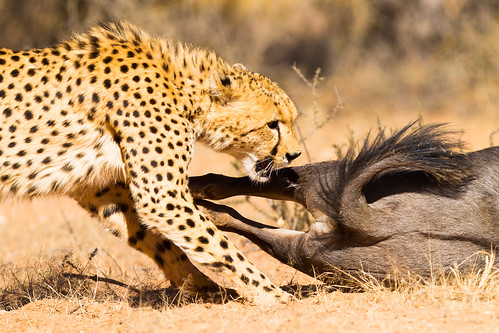一篇5日發表於Diversity and Distributions期刊的新研究指出,撒哈拉沙漠的「野生動物族群面臨災難性崩潰」,非洲獅正從撒哈拉沙漠消失,獵豹和羚羊也幾乎看不到了。研究也發現,另外三種大型哺乳動物已經從撒哈拉沙漠中滅絕。
這項由紐約野生動物保育協會(New York’s Wildlife Conservation Society)和倫敦動物學會(Zoological Society of London)主導的研究指出,北非狷羚和彎角大羚羊已在野外滅絕,非洲野狗也不再於撒哈拉沙漠出沒。其他物種的處境也沒有好到哪裡去,蒼羚和旋角羚已經從99%的原始活動範圍中消失,豹類從97%的固有活動領域裡絕跡,撒哈拉獵豹的分布範圍也縮小了90%。
此研究由來自28個學術組織超過40位學者合作,針對14個物種進行調查,發現這14個物種中,超過半數呈現地區性的滅絕,或是縮小至原來出沒範圍的1%或更小。
學者解釋,雖然過度狩獵可能是大型哺乳動物減少的原因,但當地過去至今的動盪,讓研究難以進行,因此其中仍有許多不確定性。
1萬年前,獅子是全球分布最廣的大型陸地哺乳動物,僅次於人類。幾乎出沒於整個非洲,並從西歐到印度橫跨歐亞大陸,美洲則是從加拿大的育空到南美的祕魯都有獅子的蹤跡。現在大部分的獅子生活在東非和南非,數量也逐漸減少。估計1950年代非洲獅的野外數量可高達40萬頭,1990年代約有10萬頭,2002至2004年間則已驟減至16,500到47,000頭之間。主要原因包括了疾病和人為干擾。棲地流失以及人類的衝突是對獅子最主要的威脅。
撒哈拉沙漠是全球最炎熱的沙漠,也是全球第三大荒漠,僅次於南極和北極。總面積高達9,400,000平方公里,撒哈拉沙漠東起紅海,西至大西洋,包括部分地中海沿岸,涵蓋大部分的北非地區。研究作者說,沙漠需要更多的保育支援和科學界的關注。
部分政府已經承諾保護撒哈拉沙漠和其僅存的野生動物。尼日建立了面積達97,000平方公里(37,451平方英哩)的Termit&Tin Toumma國家自然保護區,保護200隻幾乎是全球僅存的野生旋角羚、為數不多的蒼羚以及撒哈拉獵豹。在查德政府的支持下,彎角大羚羊也有望在Ouadi Rimé-Ouadi Achim禁獵區重回野外。
The African lion has vanished from the Sahara desert, while cheetahs and gazelles are nearly gone, in what scientists are calling “a catastrophic collapse of its wildlife populations” finds a study published today in the journal “Diversity and Distributions.”
Three other species of large mammals are already extinct in the Sahara desert, the study’s authors report.
An antelope known as the Bubal hartebeest is extinct, the scimitar horned oryx is extinct in the wild, and the African wild dog no longer inhabits the Sahara desert, according to the research led by New York’s Wildlife Conservation Society and the Zoological Society of London.
Other species have fared only slightly better. The dama gazelle and addax are gone from 99 percent of their range; the leopard from 97 percent its historic range, and the Saharan cheetah from 90 percent of its range.
Only the Nubian ibex still inhabits most of its range, but even this species is classified as Vulnerable due to numerous threats, including widespread hunting.
For the study, more than 40 authors from 28 scientific organizations assessed 14 desert species. They found that half of those are regionally extinct or confined to one percent or less of their historical range.
The Sahara is the world’s hottest desert, and the third largest desert after Antarctica and the Arctic. At over 9,400,000 square kilometers (3,600,000 sq miles), it covers most of northern Africa from the Red Sea, including parts of the Mediterranean coast, to the Atlantic Ocean.
A lack of scientific research in the Sahara due to past and ongoing insecurity makes it difficult to be certain of the causes of these declines across the Sahara, although overhunting has played a role, the authors explain.
Until about 10,000 years ago, the lion was the most widespread large land mammal after humans, found in most of Africa, across Eurasia from western Europe to India, and in the Americas from the Yukon to Peru.
Most lions now live in eastern and southern Africa, but they are disappearing. Estimates of the African lion population range between 16,500 and 47,000 living in the wild in 2002-2004, down from estimates in the early 1990s as high as 100,000 and up to 400,000 in 1950.
Primary causes of the decline include disease and human interference. Habitat loss and conflicts with humans are considered the most serious threats to the species.
The study’s authors say that more conservation support and scientific attention needs to be paid to deserts.
The authors note that some governments have recently made large commitments to protecting the Sahara and its remaining wildlife.
Niger has just established the massive 97,000 square kilometer (37,451 square mile) Termit and Tin Toumma National Nature Reserve, which shelters most of the world’s estimated 200 remaining wild addax and one of a few surviving populations of dama gazelle and Saharan cheetah.
There is also hope that the scimitar horned oryx may be reintroduced in the wild in the Ouadi Rimé-Ouadi Achim Game Reserve, with the support of the Chadian government.
※ 全文及圖片詳見:ENS





